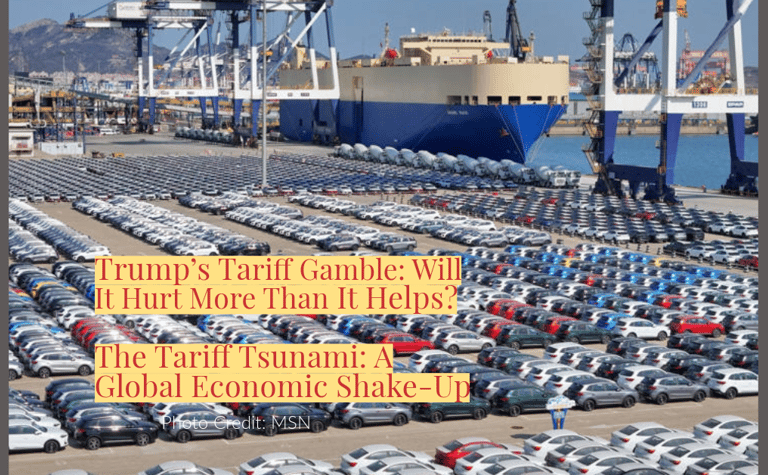Trump’s Tariff Gamble: Will It Hurt More Than It Helps?
4/19/2025


Trump’s Tariff Gamble: Will It Hurt More Than It Helps?
On April 17, 2025, the global economy is reeling from the shockwaves of President Donald Trump’s aggressive tariff policies. With a 104% tariff slapped on China, a 90-day pause on 25% tariffs for Canada and Mexico, and looming threats against the European Union, Trump’s trade war is a high-stakes gamble that’s rattling markets and reshaping international relations. The S&P 500 has shed $4 trillion since February, a stark reminder of the economic stakes (Reuters, March 10, 2025). But as consumers brace for higher prices and businesses grapple with uncertainty, the question looms: Will Trump’s tariff strategy hurt the U.S. more than it helps?
The Tariff Tsunami: A Global Economic Shake-Up
Trump’s tariff war kicked into high gear with a 104% duty on Chinese goods, announced earlier this month (BBC, April 8, 2025). This move, part of his “reciprocal” tariff strategy, aims to counter China’s trade practices and pressure Beijing on issues like fentanyl smuggling—a public health crisis Trump blames on Chinese inaction (Reuters, February 4, 2025). China, unfazed, has vowed to endure the tariffs and lodged a formal complaint with the World Trade Organization, signaling a protracted battle between the world’s two largest economies (Reuters, February 4, 2025).
Closer to home, Canada and Mexico got a temporary reprieve with a 90-day pause on their 25% tariffs, announced on February 4, 2025 (Reuters). But this pause comes with strings attached: both countries must strengthen border enforcement to curb illegal immigration and fentanyl trafficking, or face renewed tariffs (White House, February 2, 2025). Canadian canola producers, already vocal on X about economic uncertainty, fear the pause is just a delay before more trade disruptions. Mexico’s President Claudia Sheinbaum has promised retaliation if tariffs return, hinting at a tit-for-tat escalation (Reuters, March 5, 2025).
Europe, meanwhile, is on edge. Trump has threatened tariffs on EU exports, though he’s spared Britain for now (Reuters, February 4, 2025). EU leaders are preparing to “fight back” while seeking negotiation, worried about supply chain chaos and inflation (Reuters, February 4, 2025). The stakes are high: in 2024, pharmaceuticals alone were the EU’s largest export to the U.S., worth $127 billion (BBC, April 10, 2025).
Economic Fallout: Stock Losses and Stagflation Fears
The economic toll of Trump’s tariffs is already staggering. The S&P 500’s $4 trillion loss since February—equivalent to a 17% drop over five months—reflects investor panic over trade disruptions and inflation (Reuters, March 10, 2025). The Nasdaq fell 4% in a single day, one of the worst drops since the 2020 pandemic crash (Reuters, March 10, 2025). Analysts at ING warn of stagflation—a toxic mix of stagnant growth and rising inflation—as tariffs drive up costs for goods like electronics and cars (Reuters, March 5, 2025). Best Buy’s CEO, Corie Barry, noted that the 20% tariff on Chinese imports could raise household costs by $1,000 annually (Reuters, March 5, 2025).
Not all sectors are hit equally. Trump has exempted pharmaceuticals and semiconductors from the tariffs, a nod to their critical role in healthcare and technology (BBC, April 8, 2025). India, a major supplier of U.S. generics, breathed a sigh of relief, though Indian pharma stocks still dipped as companies warned of potential price hikes if tariffs expand (BBC, April 10, 2025). These exemptions highlight Trump’s strategic balancing act: pressure trading partners without crippling essential industries.
Border Enforcement: A New Trade Leverage
Trump’s tariff pause for Canada and Mexico isn’t just about trade—it’s a geopolitical chess move. The White House has tied the pause to border enforcement, demanding both countries crack down on illegal immigration and fentanyl trafficking (White House, February 2, 2025). This aligns with Trump’s long-standing “America First” agenda, using economic leverage to secure national interests. Canada’s Prime Minister Justin Trudeau has agreed to bolster border patrols, while Mexico has deployed additional resources to its northern border (Reuters, March 5, 2025). But X users, including Canadian industry groups, worry that failure to meet Trump’s demands could reignite tariffs, plunging North American trade into chaos.
China’s Defiance and the Global Ripple Effect
China’s response to the 104% tariff has been defiant. Beijing believes it can weather the storm, thanks to its diversified export markets and domestic consumption (Reuters, April 14, 2025). Its WTO challenge signals a long-term fight, while retaliatory tariffs on U.S. agricultural goods—like meats and grains—threaten American farmers, who lost $27 billion in exports during Trump’s first-term trade war (Reuters, March 5, 2025). The U.S.-China fentanyl dispute adds fuel to the fire, with China calling it “America’s problem,” further straining diplomatic ties (Reuters, February 4, 2025).
What’s Next for the U.S. Economy?
Trump’s tariff gamble is a double-edged sword. On one hand, it pressures trading partners to address U.S. concerns like fentanyl and trade imbalances. On the other hand, it risks inflation, stock market turmoil, and strained alliances. The bond market, as I discussed in a previous post, is already signaling a financial storm, with 10-year Treasury yields swinging wildly amid investor fears (BBC, April 8, 2025). For consumers, the cost of living could spike—think pricier smartphones, cars, and groceries. For businesses, supply chain disruptions could force layoffs or price hikes.
The exemptions for pharmaceuticals and semiconductors offer some relief, but they’re a small bandage on a gaping wound. As the EU braces for potential tariffs and China digs in for a prolonged trade war, the global economy hangs in the balance. Will Trump’s tariffs reshape trade in America’s favor, or will they backfire, leaving U.S. consumers and businesses to bear the brunt?
Thought-Provoking Questions:
Do you think Trump’s tariffs will force meaningful concessions from China, Canada, and Mexico, or are they pushing the U.S. into economic isolation?
How should the U.S. balance trade enforcement with the risk of inflation and stock market losses?
What industries do you believe are most vulnerable to Trump’s tariff policies, and how can they adapt?
hello@boncopia.com
+13286036419
© 2025. All rights reserved.